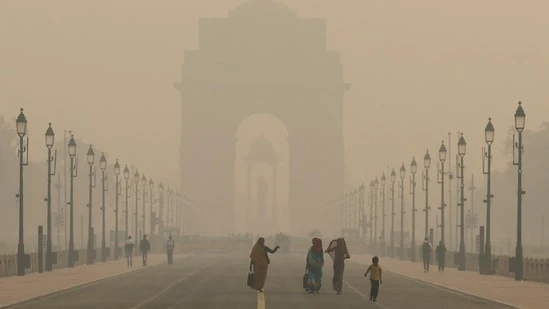Delhi remained the second most polluted city in India between January and June 2025, recording 29 days with ‘very poor’ air quality and only three days in the ‘good’ category, according to a mid-year assessment by the Centre for Research on Energy and Clean Air (CREA) released on Friday.
The independent analysis found that Delhi experienced 63 days of ‘moderate’ air quality during this period, followed by 52 days in the ‘satisfactory’ category and 31 days marked as ‘poor’. Additionally, there were three days when the air quality dipped to the ‘severe’ category.
“Delhi ranked as India’s 2nd most polluted city, with PM2.5 pollution levels reaching twice the NAAQS at 87 µg/m³,” the report stated.
It further stressed the need for a comprehensive strategy to tackle Delhi’s air pollution, suggesting that efforts must go beyond the transport and agriculture sectors. “A serious response to Delhiʼs air pollution problem requires a multi-sectoral approach that applies the same level of attention and regulatory effort to power and industry as is currently applied to transport and agriculture,” the report said.
The findings also highlighted that Delhi breached the World Health Organizations (WHO)’s annual PM2.5 guideline on January 10 and crossed the National Ambient Air Quality Standard (NAAQS) on June 5.
According to the report, this means that even if pollution levels remain low for the rest of the year, the city will still not meet either standard. The “overshoot day” is defined as a date when average pollution levels prior to that day are already high enough that even minimal daily concentrations going forward would result in annual non-compliance.
Delhi’s pollution fight needs a ‘multi-sectoral approach’
While restrictions like Delhi’s end-of-life vehicle ban play a role in managing air quality, concentrating only on emissions from vehicles overlooks other major, ongoing sources of pollution.
Despite clear directions from the Supreme Court, most thermal power plants near Delhi still lack essential pollution control systems such as flue gas desulfurization (FGD) units, according to the CREA report. By mid-2025, only two out of eleven coal-based plants within 300 kilometres of the capital – NTPC Dadri and the Mahatma Gandhi power plant – had functioning FGDs.
This gap in enforcement undermines progress achieved through stricter vehicle-related regulations and creates an imbalance in how pollution sources are addressed. While transport and agriculture are closely monitored, other sectors continue contributing significantly to pollution with little accountability.
Without swift and comprehensive action across all polluting sectors, measures like vehicle bans and seasonal restrictions will have limited impact, as ongoing emissions from other sources will continue to drive poor air quality.
Which city is the most polluted, and which is the cleanest?
Between January and June 2025, Byrnihat – a town on the Assam-Meghalaya border – recorded the highest levels of air pollution in the country, with an average PM2.5 concentration of 133 µg/m³, according to the research report.
Byrnihat experienced the majority of its days with air quality in the ‘very poor’ range (75 days), followed by 38 days in the ‘moderate’ range, 27 days classified as ‘poor’, and 13 days in the ‘severe’ category. There were 25 days with ‘satisfactory’ air quality, but not a single day met the ‘good’ category standard.
At the other end of the spectrum, “Aizawl in Mizoram emerged as the cleanest city during the first half of 2025,” with an average PM2.5 level of just 8 µg/m³. The top 10 cleanest cities included three from Karnataka, two each from Tamil Nadu and Uttar Pradesh, and one city each from Mizoram, Manipur, and Madhya Pradesh.
The list of the most polluted cities also featured Hajipur, Ghaziabad, Gurugram, Sasaram, Patna, Talcher, Rourkela, and Rajgir alongside Byrnihat and Delhi.
Among these top 10 most polluted cities, Bihar accounted for four, followed by two in Odisha. Delhi, Assam, Haryana, and Uttar Pradesh each had one city in the list.
259 out of 293 cities exceed WHO’s annual PM2.5 standards
By June 2025, 259 out of 293 monitored cities had exceeded the WHO’s annual PM2.5 limit, highlighting a broad pattern of non-compliance with international air quality standards.
The number of cities breaching the WHO benchmark varied each month: 107 in January, 114 in February, 21 in March, 10 in April, four in May, and three in June. This month-by-month pattern shows that air pollution is not limited to specific hotspots but is a widespread problem across the country.
Despite several cities consistently recording high pollution levels, only a limited number are currently part of the National Clean Air Programme (NCAP). As a result, many cities with ongoing poor air quality lack targeted strategies or action plans to curb pollution.
When compared to India’s own air quality benchmarks-the National Ambient Air Quality Standards (NAAQS)-only three cities exceeded the limit during the first half of 2025. This sharp contrast points to the limitations of the current national standards in protecting public health.
The NAAQS, established in 2009, have not been revised in over a decade. The findings underline the need for an urgent update to these standards so they are better aligned with international guidelines, including interim targets set by the WHO.
